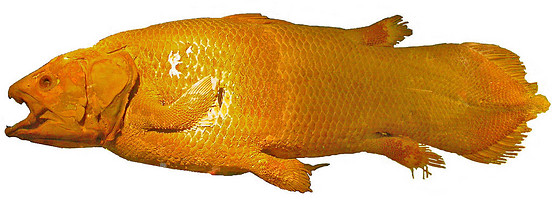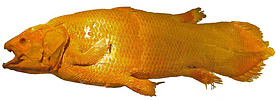Sarcopterygii
The lobe-finned fishes & terrestrial vertebrates



This tree diagram shows the relationships between several groups of organisms.
The root of the current tree connects the organisms featured in this tree to their containing group and the rest of the Tree of Life. The basal branching point in the tree represents the ancestor of the other groups in the tree. This ancestor diversified over time into several descendent subgroups, which are represented as internal nodes and terminal taxa to the right.

You can click on the root to travel down the Tree of Life all the way to the root of all Life, and you can click on the names of descendent subgroups to travel up the Tree of Life all the way to individual species.
For more information on ToL tree formatting, please see Interpreting the Tree or Classification. To learn more about phylogenetic trees, please visit our Phylogenetic Biology pages.
close boxDiscussion of Phylogenetic Relationships
There is much debate on the interrelationships of sarcopterygian fishes (for an introduction to the literature see Nelson, 1994, Carroll, 1988, and Takezaki et al. 2004). Additional information on sarcopterygians including tetrapods is being assembled for the Tree of Life project by several contributors.
References
Ahlberg, P.E. 1991. A re-examination of sarcopterygian interrelationships, with special reference to the Porolepiformes. Zoological Journal of the Linnean Society 103:241-287.
Ahlberg, P. E. and Z. Johanson. 1998. Osteolepiforms and the ancestry of tetrapods. Nature 395:792-794.
Brinkmann, H., B. Venkatesh, S. Brenner, and A. Meyer. 2004. Nuclear protein-coding genes support lungfish and not the coelacanth as the closest living relatives of land vertebrates. Proceedings of the National Academy of Sciences (USA) 101(14):4900-4905.
Cao, Y., P. J. Waddell, N. Okada, and M. Hasegawa. 1998. The complete mitochondrial DNA sequence of the shark Mustelus manazo: evaluating rooting contradictions to living bony vertebrates. Molecular Biology and Evolution 15:1637-1646.
Carroll, R. H. 1988. Vertebrate paleontology and evolution. W. H. Freeman & Co. New York.
Cloutier, R. and P. E. Ahlberg. 1995. Sarcopterygian interrelationships: how far are we from a phylogenetic consensus? Geobios Manuscrit Spécial 19:241-248.
Cloutier, R. and P. E. Ahlberg. 1996. Morphology, characters, and the interrelationships of basal sarcopterygians. Pages 445-479 in Interrelationships of Fishes (M. L. J. Stiassny, L. R. Parenti, and G. D. Johnson, eds.) Academic Press, San Diego, CA.
Daeschler, E. B., N. H. Shubin, and F. A. Jenkins, Jr. 2006. A Devonian tetrapod-like fish and the evolution of the tetrapod body plan. Nature 440:757–763.
Gorr, T., T. Kleinschmidt, and H. Fricke. 1991. Close tetrapod relationships of the coelacanth Latimeria indicated by hemoglobin sequences. Nature 351:394-397.
Hedges, S. B., C. A. Hass, and L. R. Maxson. 1993. Relations of fish and tetrapods. Nature 363:501-502.
Long, J.A.. 1989. A new rhizodontiform fish from the Early Carboniferous of Victoria, Australia, with remarks on the phylogenetic position of the group. Journal of Vertebrate Paleontology 9:1-17.
Marshall, C. and H. P. Schultze. 1992. Relative importance of molecular, neontological, and paleontological data in understanding the biology of the vertebrate invasion of land. Journal of Molecular Evolution 35:93-101.
Meyer, A. 1995. Molecular evidence on the origin of tetrapods and the relationships of the coelacanth. Trends in Ecology & Evolution 10:111-116.
Meyer, A. and S. I. Dolven. 1992. Molecules, fossils, and the origin of tetrapods. Journal of Molecular Evolution 35:102-113.
Meyer, A. and A. C. Wilson. 1990. Origin of tetrapods inferred from their mitochondrial-DNA affiliation to lungfish. Journal of Molecular Evolution 31:359-364.
Nelson, J. S. 1994. Fishes of the World. 3rd Ed. John Wiley & Sons, New York, N.Y.
Schultze, H.-P. 1994. Comparison of hypotheses on the relationships of sarcopterygians. Systematic Biology 43:155-173.
Schultze, H.-P. and E. I. Vorobyeva. 1991. Description and systematics of panderichthyid fishes with comments on their relationship to tetrapods. Pages 68-109 in Origins of the Higher Groups of Tetrapods (H.-P. Schultze and L. Trueb, eds.) Comstock Publishing Associates, Ithaca & London.
Shubin, N. H., E. B. Daeschler, and F. A. Jenkins, Jr. 2006. The pectoral fin of Tiktaalik roseae and the origin of the tetrapod limb. Nature 440:764–771.
Takezaki, N., F. Figueroa, Z. Zaleska-Rutczynska, N. Takahata, and J. Klein. 2004. The Phylogenetic Relationship of tetrapod, coelacanth, and lungfish revealed by the sequences of forty-four nuclear genes. Molecular Biology and Evolution 21(8):1512-1524.
Tohyama, Y., H. Kasama-Yoshida, M. Sakuma, Y. Kobayashi, Y. Cao, M. Hasegawa, H. Kojima, Y. Tamai, M. Tanokura, and T. Kurihara. 1999. Gene structure and amino acid sequence of Latimeria chalumnae (Coelacanth) myelin DM20: Phylogenetic relation of the fish. Neurochemical Research 24: 867-873.
Venkatesh, B., M. V. Erdmann, and S. Brenner. 2001. Molecular synapomorphies resolve evolutionary relationships of extant jawed vertebrates. Proceedings of the National Academy of Sciences (USA) 98:11382-11387.
Yokobori, S., M. Hasegawa, T. Ueda, N. Okada, K. Nishikawa, and K. Watanabe. 1994. Relationship among coelacanths, lungfishes, and tetrapods - a phylogenetic analysis based on mitochondrial cytochrome-oxidase-I gene-sequences. Journal of Molecular Evolution 38:602-609.
Zardoya, R., Y. Cao, M. Hasegawa, and A. Meyer. 1998. Searching for the closest living relative(s) of tetrapods through evolutionary analyses of mitochondrial and nuclear data. Molecular Biology And Evolution 15:506-517 .
Zardoya, R. and A. Meyer. 1996. Evolutionary relationships of the coelacanth, lungfishes, and tetrapods based on the 28S ribosomal RNA gene. Proceedings of the National Academy of Sciences (USA) 93:5449-5454.
Zardoya, R. and A. Meyer. 1996. The complete nucleotide sequence of the mitochondrial genome of the lungfish (Protopterus dolloi) supports its phylogenetic position as a close relative of land vertebrates. Genetics 142:1249-1263.
Zardoya, R. and A. Meyer. 1997. The complete DNA sequence of the mitochondrial genome of a 'living fossil,' the coelacanth (Latimeria chalumnae). Genetics 146:995-1010.
Zardoya, R. and A. Meyer. 1997. Molecular phylogenetic information on the identity of the closest living relative(s) of land vertebrates. Naturwissenschaften 84:389-397.
Zhu, M. and H.-P. Schultze. 1997. The oldest sarcopterygian fish. Lethaia 30:293-304.
Zhu, M. and X. Yu. 2002. A primitive fish close to the common ancestor of tetrapods and lungfish. Nature 418:767-770.
Information on the Internet
- The Fish Out Of Time. Information about the Coelacanth. Coelacanth Rescue Mission.
- Coelacanth: Latimeria chalumnae Smith, 1939. Australian Museum Online.
- UC Berkeley Researchers Announce Discovery of Sulawesi Coelacanths! UCMP Berkeley.
- On the Trail of the Coelacanth, a Living Fossil. Washington Post article by Susan L. Jewett.
- More about Lobe-Fin Fishes (Sarcopterygii). Dennis C. Murphy. Devonian Times.
- Tiktaalik roseae. Newly discovered sarcopterygian from the late Devonian. University of Chicago.
- What has the head of a crocodile and the gills of a fish? Information about Tiktaalik from the Understanding Evolution web site.
- Rhizodontida. Big Dead Fish Homepage. Jonathan Jeffery.
Title Illustrations

| Scientific Name | Latimeria chalumnae |
|---|---|
| Location | Vancouver Aquarium |
| Comments | Preserved coelacanth |
| Specimen Condition | Dead Specimen |
| Source | coelacanth |
| Source Collection | Flickr |
| Image Use |
 This media file is licensed under the Creative Commons Attribution-NonCommercial-NoDerivs License - Version 2.0. This media file is licensed under the Creative Commons Attribution-NonCommercial-NoDerivs License - Version 2.0.
|
| Copyright | © 2005 Matana_and_Jes |
About This Page
Page copyright © 1995
All Rights Reserved.
Citing this page:
Tree of Life Web Project. 1995. Sarcopterygii. The lobe-finned fishes & terrestrial vertebrates. Version 01 January 1995 (temporary). http://tolweb.org/Sarcopterygii/14922/1995.01.01 in The Tree of Life Web Project, http://tolweb.org/







 Go to quick links
Go to quick search
Go to navigation for this section of the ToL site
Go to detailed links for the ToL site
Go to quick links
Go to quick search
Go to navigation for this section of the ToL site
Go to detailed links for the ToL site